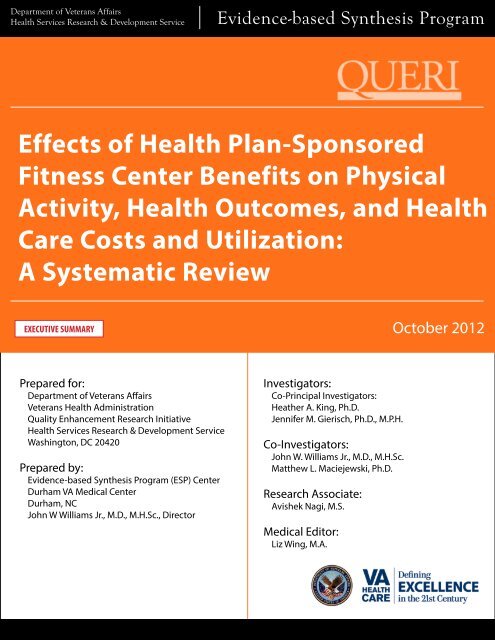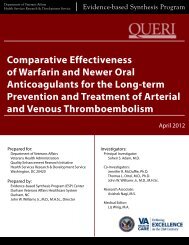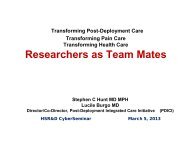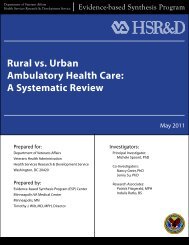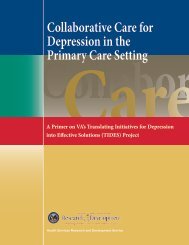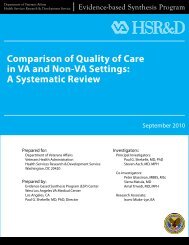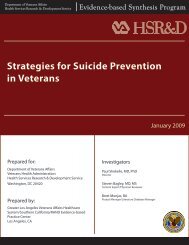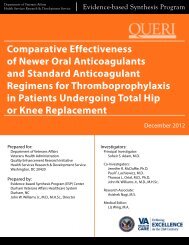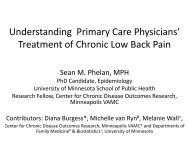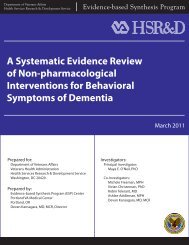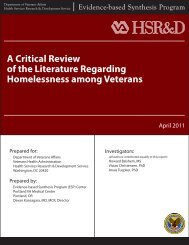Effects of Health Plan-Sponsored Fitness Center Benefits on ...
Effects of Health Plan-Sponsored Fitness Center Benefits on ...
Effects of Health Plan-Sponsored Fitness Center Benefits on ...
Create successful ePaper yourself
Turn your PDF publications into a flip-book with our unique Google optimized e-Paper software.
Department <str<strong>on</strong>g>of</str<strong>on</strong>g> Veterans Affairs<br />
<str<strong>on</strong>g>Health</str<strong>on</strong>g> Services Research & Development Service<br />
Evidence-based Synthesis Program<br />
<str<strong>on</strong>g>Effects</str<strong>on</strong>g> <str<strong>on</strong>g>of</str<strong>on</strong>g> <str<strong>on</strong>g>Health</str<strong>on</strong>g> <str<strong>on</strong>g>Plan</str<strong>on</strong>g>-<str<strong>on</strong>g>Sp<strong>on</strong>sored</str<strong>on</strong>g><br />
<str<strong>on</strong>g>Fitness</str<strong>on</strong>g> <str<strong>on</strong>g>Center</str<strong>on</strong>g> <str<strong>on</strong>g>Benefits</str<strong>on</strong>g> <strong>on</strong> Physical<br />
Activity, <str<strong>on</strong>g>Health</str<strong>on</strong>g> Outcomes, and <str<strong>on</strong>g>Health</str<strong>on</strong>g><br />
Care Costs and Utilizati<strong>on</strong>:<br />
A Systematic Review<br />
EXECUTIVE SUMMARY<br />
October 2012<br />
Prepared for:<br />
Department <str<strong>on</strong>g>of</str<strong>on</strong>g> Veterans Affairs<br />
Veterans <str<strong>on</strong>g>Health</str<strong>on</strong>g> Administrati<strong>on</strong><br />
Quality Enhancement Research Initiative<br />
<str<strong>on</strong>g>Health</str<strong>on</strong>g> Services Research & Development Service<br />
Washingt<strong>on</strong>, DC 20420<br />
Prepared by:<br />
Evidence-based Synthesis Program (ESP) <str<strong>on</strong>g>Center</str<strong>on</strong>g><br />
Durham VA Medical <str<strong>on</strong>g>Center</str<strong>on</strong>g><br />
Durham, NC<br />
John W Williams Jr., M.D., M.H.Sc., Director<br />
Investigators:<br />
Co-Principal Investigators:<br />
Heather A. King, Ph.D.<br />
Jennifer M. Gierisch, Ph.D., M.P.H.<br />
Co-Investigators:<br />
John W. Williams Jr., M.D., M.H.Sc.<br />
Matthew L. Maciejewski, Ph.D.<br />
Research Associate:<br />
Avishek Nagi, M.S.<br />
Medical Editor:<br />
Liz Wing, M.A.
<str<strong>on</strong>g>Effects</str<strong>on</strong>g> <str<strong>on</strong>g>of</str<strong>on</strong>g> <str<strong>on</strong>g>Health</str<strong>on</strong>g> <str<strong>on</strong>g>Plan</str<strong>on</strong>g>-<str<strong>on</strong>g>Sp<strong>on</strong>sored</str<strong>on</strong>g> <str<strong>on</strong>g>Fitness</str<strong>on</strong>g> <str<strong>on</strong>g>Center</str<strong>on</strong>g> <str<strong>on</strong>g>Benefits</str<strong>on</strong>g><br />
Evidence-based Synthesis Program<br />
PREFACE<br />
Quality Enhancement Research Initiative’s (QUERI’s) Evidence-based Synthesis Program<br />
(ESP) was established to provide timely and accurate syntheses <str<strong>on</strong>g>of</str<strong>on</strong>g> targeted healthcare topics<br />
<str<strong>on</strong>g>of</str<strong>on</strong>g> particular importance to Veterans Affairs (VA) managers and policymakers, as they work to<br />
improve the health and healthcare <str<strong>on</strong>g>of</str<strong>on</strong>g> Veterans. The ESP disseminates these reports throughout<br />
VA.<br />
QUERI provides funding for four ESP <str<strong>on</strong>g>Center</str<strong>on</strong>g>s and each <str<strong>on</strong>g>Center</str<strong>on</strong>g> has an active VA affiliati<strong>on</strong>. The<br />
ESP <str<strong>on</strong>g>Center</str<strong>on</strong>g>s generate evidence syntheses <strong>on</strong> important clinical practice topics, and these reports<br />
help:<br />
• develop clinical policies informed by evidence,<br />
• guide the implementati<strong>on</strong> <str<strong>on</strong>g>of</str<strong>on</strong>g> effective services to improve patient outcomes and to<br />
support VA clinical practice guidelines and performance measures, and<br />
• set the directi<strong>on</strong> for future research to address gaps in clinical knowledge.<br />
In 2009, the ESP Coordinating <str<strong>on</strong>g>Center</str<strong>on</strong>g> was created to expand the capacity <str<strong>on</strong>g>of</str<strong>on</strong>g> QUERI Central<br />
Office and the four ESP sites by developing and maintaining program processes. In additi<strong>on</strong>,<br />
the <str<strong>on</strong>g>Center</str<strong>on</strong>g> established a Steering Committee comprised <str<strong>on</strong>g>of</str<strong>on</strong>g> QUERI field-based investigators,<br />
VA Patient Care Services, Office <str<strong>on</strong>g>of</str<strong>on</strong>g> Quality and Performance, and Veterans Integrated Service<br />
Networks (VISN) Clinical Management Officers. The Steering Committee provides program<br />
oversight, guides strategic planning, coordinates disseminati<strong>on</strong> activities, and develops<br />
collaborati<strong>on</strong>s with VA leadership to identify new ESP topics <str<strong>on</strong>g>of</str<strong>on</strong>g> importance to Veterans and the<br />
VA healthcare system.<br />
Comments <strong>on</strong> this evidence report are welcome and can be sent to Nicole Floyd, ESP<br />
Coordinating <str<strong>on</strong>g>Center</str<strong>on</strong>g> Program Manager, at nicole.floyd@va.gov.<br />
Recommended citati<strong>on</strong>: King HA, Gierisch JM, Williams JW Jr, Maciejewski ML. <str<strong>on</strong>g>Effects</str<strong>on</strong>g> <str<strong>on</strong>g>of</str<strong>on</strong>g><br />
<str<strong>on</strong>g>Health</str<strong>on</strong>g> <str<strong>on</strong>g>Plan</str<strong>on</strong>g>-<str<strong>on</strong>g>Sp<strong>on</strong>sored</str<strong>on</strong>g> <str<strong>on</strong>g>Fitness</str<strong>on</strong>g> <str<strong>on</strong>g>Center</str<strong>on</strong>g> <str<strong>on</strong>g>Benefits</str<strong>on</strong>g> <strong>on</strong> Physical Activity, <str<strong>on</strong>g>Health</str<strong>on</strong>g> Outcomes, and<br />
<str<strong>on</strong>g>Health</str<strong>on</strong>g> Care Costs and Utilizati<strong>on</strong>: A Systematic Review. VA-ESP Project #09-010; 2012.<br />
This report is based <strong>on</strong> research c<strong>on</strong>ducted by the Evidence-based Synthesis Program<br />
(ESP) <str<strong>on</strong>g>Center</str<strong>on</strong>g> located at the Durham VA Medical <str<strong>on</strong>g>Center</str<strong>on</strong>g>, Durham, NC, funded by the<br />
Department <str<strong>on</strong>g>of</str<strong>on</strong>g> Veterans Affairs, Veterans <str<strong>on</strong>g>Health</str<strong>on</strong>g> Administrati<strong>on</strong>, Office <str<strong>on</strong>g>of</str<strong>on</strong>g> Research<br />
and Development, <str<strong>on</strong>g>Health</str<strong>on</strong>g> Services Research and Development. The findings and<br />
c<strong>on</strong>clusi<strong>on</strong>s in this document are those <str<strong>on</strong>g>of</str<strong>on</strong>g> the author(s) who are resp<strong>on</strong>sible for its<br />
c<strong>on</strong>tents; the findings and c<strong>on</strong>clusi<strong>on</strong>s do not necessarily represent the views <str<strong>on</strong>g>of</str<strong>on</strong>g><br />
the Department <str<strong>on</strong>g>of</str<strong>on</strong>g> Veterans Affairs or the United States government. Therefore, no<br />
statement in this article should be c<strong>on</strong>strued as an <str<strong>on</strong>g>of</str<strong>on</strong>g>ficial positi<strong>on</strong> <str<strong>on</strong>g>of</str<strong>on</strong>g> the Department<br />
<str<strong>on</strong>g>of</str<strong>on</strong>g> Veterans Affairs. No investigators have any affiliati<strong>on</strong>s or financial involvement (e.g.,<br />
employment, c<strong>on</strong>sultancies, h<strong>on</strong>oraria, stock ownership or opti<strong>on</strong>s, expert testim<strong>on</strong>y,<br />
grants or patents received or pending, or royalties) that c<strong>on</strong>¬flict with material presented<br />
in the report.<br />
i
<str<strong>on</strong>g>Effects</str<strong>on</strong>g> <str<strong>on</strong>g>of</str<strong>on</strong>g> <str<strong>on</strong>g>Health</str<strong>on</strong>g> <str<strong>on</strong>g>Plan</str<strong>on</strong>g>-<str<strong>on</strong>g>Sp<strong>on</strong>sored</str<strong>on</strong>g> <str<strong>on</strong>g>Fitness</str<strong>on</strong>g> <str<strong>on</strong>g>Center</str<strong>on</strong>g> <str<strong>on</strong>g>Benefits</str<strong>on</strong>g><br />
Evidence-based Synthesis Program<br />
EXECUTIVE SUMMARY<br />
BACKGROUND<br />
Regular physical activity has many positive health benefits, including protecti<strong>on</strong> against chr<strong>on</strong>ic<br />
disease, improved physical and mental health and cognitive functi<strong>on</strong>, and better health-related<br />
related quality <str<strong>on</strong>g>of</str<strong>on</strong>g> life. Moreover, lack <str<strong>on</strong>g>of</str<strong>on</strong>g> physical activity is associated with higher health<br />
care costs and utilizati<strong>on</strong>. Many Americans, however, do not get the recommended levels <str<strong>on</strong>g>of</str<strong>on</strong>g><br />
physical activity. For Veterans, Veterans Affairs (VA) health care users are less likely to meet<br />
physical activity recommendati<strong>on</strong>s and more likely to be physically inactive compared with<br />
Veterans who do not use VA health care. Multiple pers<strong>on</strong>al, social, and envir<strong>on</strong>mental factors<br />
influence participati<strong>on</strong> in physical activity. Providing memberships to fitness centers may be<br />
a viable opti<strong>on</strong> to increase physical activity and the positive health outcomes associated with<br />
such activity. Given that most Americans have access to some form <str<strong>on</strong>g>of</str<strong>on</strong>g> health insurance, health<br />
plan promoti<strong>on</strong> <str<strong>on</strong>g>of</str<strong>on</strong>g> and coverage for fitness center memberships has the potential to address<br />
multiple barriers to physical activity (e.g., cost, access) and extend fitness center access to many<br />
Americans.<br />
Our objective in this evidence synthesis was to summarize the results <str<strong>on</strong>g>of</str<strong>on</strong>g> diverse studies <str<strong>on</strong>g>of</str<strong>on</strong>g> health<br />
plan-sp<strong>on</strong>sored fitness center memberships in an effort to understand how these benefits affect<br />
physical activity, clinical outcomes, health care costs and utilizati<strong>on</strong>, retenti<strong>on</strong> <str<strong>on</strong>g>of</str<strong>on</strong>g> plan members,<br />
and member satisfacti<strong>on</strong>.<br />
Key Questi<strong>on</strong> 1. What are the effects <str<strong>on</strong>g>of</str<strong>on</strong>g> policy/benefits packages that include vouchers, rebates,<br />
premium reducti<strong>on</strong>s, or other ec<strong>on</strong>omic incentives to encourage physical activity through fitness<br />
center memberships <strong>on</strong>:<br />
(a) Physical activity participati<strong>on</strong> rates am<strong>on</strong>g plan members?<br />
(b) <str<strong>on</strong>g>Health</str<strong>on</strong>g> outcomes dem<strong>on</strong>strated to be improved by physical activity (i.e., weight, pain,<br />
glucose, blood pressure, health-related quality <str<strong>on</strong>g>of</str<strong>on</strong>g> life)?<br />
(c) Overall health care costs and health care utilizati<strong>on</strong>?<br />
Key Questi<strong>on</strong> 2. What are the effects <str<strong>on</strong>g>of</str<strong>on</strong>g> policy/benefits packages that include vouchers, rebates,<br />
premium reducti<strong>on</strong>s, or other ec<strong>on</strong>omic incentives to encourage physical activity through fitness<br />
center memberships <strong>on</strong> satisfacti<strong>on</strong> with the health plan and retenti<strong>on</strong> <str<strong>on</strong>g>of</str<strong>on</strong>g> members in the health<br />
plan?<br />
Key Questi<strong>on</strong> 3. Do the effects <str<strong>on</strong>g>of</str<strong>on</strong>g> policy/benefits packages to encourage physical activity vary<br />
by specific characteristics <str<strong>on</strong>g>of</str<strong>on</strong>g> the package (premium vs. lump sum) or age, sex, and physical<br />
illness <str<strong>on</strong>g>of</str<strong>on</strong>g> participants?<br />
1
<str<strong>on</strong>g>Effects</str<strong>on</strong>g> <str<strong>on</strong>g>of</str<strong>on</strong>g> <str<strong>on</strong>g>Health</str<strong>on</strong>g> <str<strong>on</strong>g>Plan</str<strong>on</strong>g>-<str<strong>on</strong>g>Sp<strong>on</strong>sored</str<strong>on</strong>g> <str<strong>on</strong>g>Fitness</str<strong>on</strong>g> <str<strong>on</strong>g>Center</str<strong>on</strong>g> <str<strong>on</strong>g>Benefits</str<strong>on</strong>g><br />
Evidence-based Synthesis Program<br />
METHODS<br />
In c<strong>on</strong>sultati<strong>on</strong> with a master librarian, we searched MEDLINE ® (via PubMed ® ), Embase ® , and<br />
the Cochrane Database <str<strong>on</strong>g>of</str<strong>on</strong>g> Systematic Reviews for peer-reviewed publicati<strong>on</strong>s comparing health<br />
plan-sp<strong>on</strong>sored strategies to encourage physical activity through fitness center memberships<br />
with standard benefit plans from database incepti<strong>on</strong> through January 2012. We selected freetext<br />
terms to search titles and abstracts as well as validated search terms for both randomized<br />
c<strong>on</strong>trolled trials and relevant observati<strong>on</strong>al studies adapted from the Cochrane Effective Practice<br />
& Organizati<strong>on</strong> <str<strong>on</strong>g>of</str<strong>on</strong>g> Care Group search, versi<strong>on</strong> 1.9. We limited the search to articles published<br />
in the English language involving human subjects 18 years <str<strong>on</strong>g>of</str<strong>on</strong>g> age and older. An updated search<br />
for publicati<strong>on</strong>s was c<strong>on</strong>ducted in May 2012. We also evaluated the bibliographies <str<strong>on</strong>g>of</str<strong>on</strong>g> included<br />
primary studies. As a mechanism to assess the risk <str<strong>on</strong>g>of</str<strong>on</strong>g> publicati<strong>on</strong> bias, we searched www.<br />
ClinicalTrials.gov for completed but unpublished studies in July 2012.<br />
DATA SYNTHESIS<br />
We critically analyzed studies to compare their characteristics, methods, and findings to determine<br />
the feasibility <str<strong>on</strong>g>of</str<strong>on</strong>g> completing a quantitative synthesis (i.e., meta-analysis) based <strong>on</strong> the volume <str<strong>on</strong>g>of</str<strong>on</strong>g><br />
relevant literature, the completeness <str<strong>on</strong>g>of</str<strong>on</strong>g> the results reported and the c<strong>on</strong>ceptual homogeneity <str<strong>on</strong>g>of</str<strong>on</strong>g> the<br />
studies. As quantitative synthesis was not possible, we analyzed the results qualitatively.<br />
RATING THE BODY OF EVIDENCE<br />
In additi<strong>on</strong> to rating the quality <str<strong>on</strong>g>of</str<strong>on</strong>g> individual studies, we evaluated the overall strength <str<strong>on</strong>g>of</str<strong>on</strong>g><br />
evidence (SOE) for each Key Questi<strong>on</strong> by assessing the following domains: risk <str<strong>on</strong>g>of</str<strong>on</strong>g> bias,<br />
c<strong>on</strong>sistency, directness, precisi<strong>on</strong>, strength <str<strong>on</strong>g>of</str<strong>on</strong>g> associati<strong>on</strong> (magnitude <str<strong>on</strong>g>of</str<strong>on</strong>g> effect), and publicati<strong>on</strong><br />
bias. These domains were c<strong>on</strong>sidered qualitatively, and a summary rating <str<strong>on</strong>g>of</str<strong>on</strong>g> high, moderate, low,<br />
or insufficient SOE was assigned.<br />
PEER REVIEW<br />
A draft versi<strong>on</strong> <str<strong>on</strong>g>of</str<strong>on</strong>g> the report was reviewed by technical experts and clinical leadership. A<br />
transcript <str<strong>on</strong>g>of</str<strong>on</strong>g> their comments can be found in the appendix, which elucidates how each comment<br />
was c<strong>on</strong>sidered in the final report.<br />
RESULTS<br />
We identified 3584 unique citati<strong>on</strong>s from a combined search <str<strong>on</strong>g>of</str<strong>on</strong>g> MEDLINE (via PubMed,<br />
n=3560), Embase (n=24), and the Cochrane database (n=0). Manual searching <str<strong>on</strong>g>of</str<strong>on</strong>g> included study<br />
bibliographies and review articles identified 5 additi<strong>on</strong>al citati<strong>on</strong>s for a total <str<strong>on</strong>g>of</str<strong>on</strong>g> 3589 citati<strong>on</strong>s.<br />
After applying inclusi<strong>on</strong>/exclusi<strong>on</strong> criteria, 4 articles (representing 1 unique study) were included<br />
in this review. Most studies were excluded because they assessed types <str<strong>on</strong>g>of</str<strong>on</strong>g> physical activity<br />
promoti<strong>on</strong> strategies other than fitness center memberships (e.g., worksite wellness). Our search<br />
<str<strong>on</strong>g>of</str<strong>on</strong>g> www.ClinicalTrials.gov did not suggest publicati<strong>on</strong> bias. There were no completed studies that<br />
were unpublished. In additi<strong>on</strong>, there were no <strong>on</strong>going studies <strong>on</strong> this topic.<br />
2
<str<strong>on</strong>g>Effects</str<strong>on</strong>g> <str<strong>on</strong>g>of</str<strong>on</strong>g> <str<strong>on</strong>g>Health</str<strong>on</strong>g> <str<strong>on</strong>g>Plan</str<strong>on</strong>g>-<str<strong>on</strong>g>Sp<strong>on</strong>sored</str<strong>on</strong>g> <str<strong>on</strong>g>Fitness</str<strong>on</strong>g> <str<strong>on</strong>g>Center</str<strong>on</strong>g> <str<strong>on</strong>g>Benefits</str<strong>on</strong>g><br />
Evidence-based Synthesis Program<br />
All articles we identified addressed KQ 1; n<strong>on</strong>e addressed KQ 2 or KQ 3 (Table ES-1). The main<br />
study was a retrospective cohort study rated fair quality that used administrative and claims<br />
data to assess the health care and utilizati<strong>on</strong> effects <str<strong>on</strong>g>of</str<strong>on</strong>g> a health plan-sp<strong>on</strong>sored fitness center<br />
membership benefit (known as the Silver Sneakers program) am<strong>on</strong>g adults 65 years <str<strong>on</strong>g>of</str<strong>on</strong>g> age and<br />
older who were enrolled in the Group <str<strong>on</strong>g>Health</str<strong>on</strong>g> Cooperative <str<strong>on</strong>g>of</str<strong>on</strong>g> Puget Sound Medicare Advantage<br />
plan. Two compani<strong>on</strong> articles assessed the effect <str<strong>on</strong>g>of</str<strong>on</strong>g> distance from the fitness center and history <str<strong>on</strong>g>of</str<strong>on</strong>g><br />
depressi<strong>on</strong> <strong>on</strong> the uptake <str<strong>on</strong>g>of</str<strong>on</strong>g> fitness center benefits and frequency <str<strong>on</strong>g>of</str<strong>on</strong>g> use am<strong>on</strong>g participants. One<br />
additi<strong>on</strong>al compani<strong>on</strong> article assessed the effect <str<strong>on</strong>g>of</str<strong>on</strong>g> this benefit <strong>on</strong> health care costs and utilizati<strong>on</strong><br />
am<strong>on</strong>g health plan members with diabetes. The Silver Sneakers program assessed in all analyses<br />
allowed eligible health plan enrollees 65 years <str<strong>on</strong>g>of</str<strong>on</strong>g> age and older to access selected fitness centers<br />
and all activities (e.g., structured c<strong>on</strong>diti<strong>on</strong>ing classes) and facilities (e.g., exercise equipment,<br />
pool) associated with these fitness centers. The health plan covered the full cost <str<strong>on</strong>g>of</str<strong>on</strong>g> memberships<br />
for each year; there were no additi<strong>on</strong>al costs to the member for the fitness center membership.<br />
Table ES-1. Overview <str<strong>on</strong>g>of</str<strong>on</strong>g> articles evaluating effects <str<strong>on</strong>g>of</str<strong>on</strong>g> fitness center membership<br />
Reference Study Details KQ Included Outcomes<br />
Main study<br />
Nguyen et al.,<br />
2008<br />
Group <str<strong>on</strong>g>Health</str<strong>on</strong>g> Cooperative Medicare<br />
Advantage enrollees ≥ age 65<br />
Selecti<strong>on</strong> dates: Jan 1998–Dec 2003<br />
Participants: 4766 benefit users<br />
Matched c<strong>on</strong>trols: 9035 benefit n<strong>on</strong>users<br />
Compani<strong>on</strong> articles<br />
Berke et al., 2006 Group <str<strong>on</strong>g>Health</str<strong>on</strong>g> Cooperative Medicare<br />
Advantage enrollees ≥ age 65<br />
Nguyen et al.,<br />
2008<br />
Nguyen et al.,<br />
2008<br />
Selecti<strong>on</strong> dates: Jan 2002–Dec 2003<br />
Participants: 1728 benefit users<br />
Matched c<strong>on</strong>trols: 4838 benefit n<strong>on</strong>users<br />
Group <str<strong>on</strong>g>Health</str<strong>on</strong>g> Cooperative Medicare<br />
Advantage enrollees ≥ age 65<br />
Selecti<strong>on</strong> dates: Jan 1998–Dec 2003<br />
Participants: 4766 benefit users<br />
Matched c<strong>on</strong>trols: 9035 benefit n<strong>on</strong>users<br />
Group <str<strong>on</strong>g>Health</str<strong>on</strong>g> Cooperative Medicare<br />
Advantage enrollees ≥ age 65<br />
Selecti<strong>on</strong> dates: Jan 1998–Dec 2003<br />
Participants: 618 benefit users with diabetes<br />
Matched c<strong>on</strong>trols: 1413 benefit n<strong>on</strong>users with<br />
diabetes<br />
1a<br />
1c<br />
1a<br />
1a<br />
1a<br />
1c<br />
• Physical activity participati<strong>on</strong><br />
• <str<strong>on</strong>g>Health</str<strong>on</strong>g> care cost<br />
• <str<strong>on</strong>g>Health</str<strong>on</strong>g> care utilizati<strong>on</strong><br />
Role <str<strong>on</strong>g>of</str<strong>on</strong>g> distance from fitness center <strong>on</strong>:<br />
• Uptake <str<strong>on</strong>g>of</str<strong>on</strong>g> benefit<br />
• Frequency <str<strong>on</strong>g>of</str<strong>on</strong>g> use <str<strong>on</strong>g>of</str<strong>on</strong>g> benefit<br />
Role <str<strong>on</strong>g>of</str<strong>on</strong>g> depressi<strong>on</strong> history <strong>on</strong>:<br />
• Uptake <str<strong>on</strong>g>of</str<strong>on</strong>g> benefit<br />
• Frequency <str<strong>on</strong>g>of</str<strong>on</strong>g> use <str<strong>on</strong>g>of</str<strong>on</strong>g> benefit, risk <str<strong>on</strong>g>of</str<strong>on</strong>g><br />
participati<strong>on</strong> lapse<br />
• Physical activity participati<strong>on</strong><br />
• <str<strong>on</strong>g>Health</str<strong>on</strong>g> care cost<br />
• <str<strong>on</strong>g>Health</str<strong>on</strong>g> care utilizati<strong>on</strong><br />
3
<str<strong>on</strong>g>Effects</str<strong>on</strong>g> <str<strong>on</strong>g>of</str<strong>on</strong>g> <str<strong>on</strong>g>Health</str<strong>on</strong>g> <str<strong>on</strong>g>Plan</str<strong>on</strong>g>-<str<strong>on</strong>g>Sp<strong>on</strong>sored</str<strong>on</strong>g> <str<strong>on</strong>g>Fitness</str<strong>on</strong>g> <str<strong>on</strong>g>Center</str<strong>on</strong>g> <str<strong>on</strong>g>Benefits</str<strong>on</strong>g><br />
Evidence-based Synthesis Program<br />
Key Questi<strong>on</strong> 1. What are the effects <str<strong>on</strong>g>of</str<strong>on</strong>g> policy/benefits packages that include<br />
vouchers, rebates, premium reducti<strong>on</strong>s, or other ec<strong>on</strong>omic incentives to<br />
encourage physical activity through fitness center memberships <strong>on</strong>:<br />
(a) Physical activity participati<strong>on</strong> rates am<strong>on</strong>g plan members?<br />
(b) <str<strong>on</strong>g>Health</str<strong>on</strong>g> outcomes dem<strong>on</strong>strated to be improved by physical activity<br />
(i.e., weight, pain, glucose, blood pressure, health-related quality <str<strong>on</strong>g>of</str<strong>on</strong>g> life)?<br />
(c) Overall health care costs and health care utilizati<strong>on</strong>?<br />
KQ 1a: Physical Activity Participati<strong>on</strong><br />
N<strong>on</strong>e <str<strong>on</strong>g>of</str<strong>on</strong>g> the included articles assessed physical activity as a primary outcome. The <strong>on</strong>ly metric <str<strong>on</strong>g>of</str<strong>on</strong>g><br />
physical activity was the frequency <str<strong>on</strong>g>of</str<strong>on</strong>g> fitness center visits by participants in the Silver Sneakers<br />
program such as that reported in the main study and <strong>on</strong>e compani<strong>on</strong> article. Two additi<strong>on</strong>al<br />
compani<strong>on</strong> articles assessed the associati<strong>on</strong>s between (1) the distance from the fitness center<br />
and (2) a history <str<strong>on</strong>g>of</str<strong>on</strong>g> depressi<strong>on</strong> <strong>on</strong> the uptake and frequency <str<strong>on</strong>g>of</str<strong>on</strong>g> use <str<strong>on</strong>g>of</str<strong>on</strong>g> the health plan-sp<strong>on</strong>sored<br />
fitness center membership benefit.<br />
In Year 1 <str<strong>on</strong>g>of</str<strong>on</strong>g> the main study, Silver Sneakers participants averaged 75 visits (median 49;<br />
interquartile range [IQR] 11 to 120). In Year 2, the average number <str<strong>on</strong>g>of</str<strong>on</strong>g> visits declined to 55<br />
(median 12; IQR 0 to 89). While participati<strong>on</strong> dropped in Year 2, 61 percent <str<strong>on</strong>g>of</str<strong>on</strong>g> participants<br />
c<strong>on</strong>tinued to visit fitness centers. A separate analysis using a subset <str<strong>on</strong>g>of</str<strong>on</strong>g> members with diabetes<br />
from the main study reported similar number <str<strong>on</strong>g>of</str<strong>on</strong>g> average visits per year (72 visits in Year 1, 49<br />
visits in Year 2).<br />
Two compani<strong>on</strong> articles provided informati<strong>on</strong> <strong>on</strong> other factors associated with uptake and<br />
frequency <str<strong>on</strong>g>of</str<strong>on</strong>g> use. Additi<strong>on</strong>al analyses suggest that distance from fitness centers and history <str<strong>on</strong>g>of</str<strong>on</strong>g><br />
depressi<strong>on</strong> influence the uptake <str<strong>on</strong>g>of</str<strong>on</strong>g> health plan-sp<strong>on</strong>sored fitness center memberships. Enrollment<br />
in a fitness center and frequency <str<strong>on</strong>g>of</str<strong>on</strong>g> use are both associated with distance from gyms. While<br />
history <str<strong>on</strong>g>of</str<strong>on</strong>g> depressi<strong>on</strong> is not associated with participati<strong>on</strong> in a fitness center benefit, health plan<br />
members with a history <str<strong>on</strong>g>of</str<strong>on</strong>g> depressi<strong>on</strong> made fewer visits and were at greater risk <str<strong>on</strong>g>of</str<strong>on</strong>g> lapses in their<br />
participati<strong>on</strong> compared with n<strong>on</strong>depressed members.<br />
KQ 1b: Physical <str<strong>on</strong>g>Health</str<strong>on</strong>g> Outcomes<br />
No identified studies addressed KQ 1b.<br />
KQ 1c: <str<strong>on</strong>g>Health</str<strong>on</strong>g> Care Costs and Utilizati<strong>on</strong><br />
The main study and <strong>on</strong>e compani<strong>on</strong> article reported the effects <str<strong>on</strong>g>of</str<strong>on</strong>g> health plan-sp<strong>on</strong>sored fitness<br />
center memberships <strong>on</strong> health care costs and utilizati<strong>on</strong>. In adjusted models for Year 1, Nguyen<br />
et al. reported that adjusted total health care costs were not different between Silver Sneakers<br />
participants and n<strong>on</strong>participants. By the end <str<strong>on</strong>g>of</str<strong>on</strong>g> Year 2, participants incurred significantly<br />
lower total health care costs (-$500; CI -$892 to -$106, p=0.01) likely due to fewer inpatient<br />
admissi<strong>on</strong>s and lower inpatient care costs compared with c<strong>on</strong>trols. There was evidence <str<strong>on</strong>g>of</str<strong>on</strong>g> a doseresp<strong>on</strong>se<br />
by average number <str<strong>on</strong>g>of</str<strong>on</strong>g> health club visits. Compared with participants who attended<br />
4
<str<strong>on</strong>g>Effects</str<strong>on</strong>g> <str<strong>on</strong>g>of</str<strong>on</strong>g> <str<strong>on</strong>g>Health</str<strong>on</strong>g> <str<strong>on</strong>g>Plan</str<strong>on</strong>g>-<str<strong>on</strong>g>Sp<strong>on</strong>sored</str<strong>on</strong>g> <str<strong>on</strong>g>Fitness</str<strong>on</strong>g> <str<strong>on</strong>g>Center</str<strong>on</strong>g> <str<strong>on</strong>g>Benefits</str<strong>on</strong>g><br />
Evidence-based Synthesis Program<br />
fitness centers less than <strong>on</strong>e time per week, participants who averaged two to less than three or<br />
three or more visits per week over 2 years had lower adjusted health care costs (2 to
<str<strong>on</strong>g>Effects</str<strong>on</strong>g> <str<strong>on</strong>g>of</str<strong>on</strong>g> <str<strong>on</strong>g>Health</str<strong>on</strong>g> <str<strong>on</strong>g>Plan</str<strong>on</strong>g>-<str<strong>on</strong>g>Sp<strong>on</strong>sored</str<strong>on</strong>g> <str<strong>on</strong>g>Fitness</str<strong>on</strong>g> <str<strong>on</strong>g>Center</str<strong>on</strong>g> <str<strong>on</strong>g>Benefits</str<strong>on</strong>g><br />
Evidence-based Synthesis Program<br />
Table ES-2. Evidence gaps and future research<br />
Evidence Gap Reas<strong>on</strong> Type <str<strong>on</strong>g>of</str<strong>on</strong>g> Studies to C<strong>on</strong>sider<br />
Patients<br />
Absence <str<strong>on</strong>g>of</str<strong>on</strong>g> data for patients<br />
other than those ≥ age 65<br />
Interventi<strong>on</strong>s<br />
Silver Sneakers program was the<br />
<strong>on</strong>ly benefit assessed<br />
Outcomes<br />
Uncertain effects <strong>on</strong>:<br />
• Physical activity levels<br />
• Physical health outcomes<br />
• <str<strong>on</strong>g>Health</str<strong>on</strong>g> care costs and<br />
utilizati<strong>on</strong><br />
Uncertain effects <strong>on</strong> health plan<br />
member:<br />
• Satisfacti<strong>on</strong><br />
• Retenti<strong>on</strong><br />
Abbreviati<strong>on</strong>: RCT = randomized c<strong>on</strong>trolled trial<br />
CONCLUSION<br />
Insufficient informati<strong>on</strong><br />
Insufficient informati<strong>on</strong><br />
Insufficient informati<strong>on</strong><br />
Insufficient informati<strong>on</strong><br />
• Multisite cluster RCTs<br />
• Quasi-experimental studies<br />
• Prospective cohort studies<br />
• RCTs <str<strong>on</strong>g>of</str<strong>on</strong>g> head-to-head comparis<strong>on</strong>s <str<strong>on</strong>g>of</str<strong>on</strong>g> different<br />
types <str<strong>on</strong>g>of</str<strong>on</strong>g> benefit structures<br />
• Quasi-experimental studies comparing different<br />
types <str<strong>on</strong>g>of</str<strong>on</strong>g> policy changes that impact benefit<br />
structures<br />
• Multisite cluster RCTs<br />
• Prospective cohort studies<br />
• N<strong>on</strong>randomized trials (pre-post designs)<br />
• N<strong>on</strong>randomized c<strong>on</strong>trolled before-and-after studies<br />
• Multisite cluster RCTs<br />
• Prospective or retrospective cohort studies<br />
• N<strong>on</strong>randomized c<strong>on</strong>trolled before-and-after studies<br />
• Qualitative studies<br />
<str<strong>on</strong>g>Health</str<strong>on</strong>g> plan-sp<strong>on</strong>sored fitness center memberships have the potential to increase levels <str<strong>on</strong>g>of</str<strong>on</strong>g> physical<br />
activity and, subsequently, improve health and ec<strong>on</strong>omic outcomes for Veterans. However, few<br />
studies have assessed the impact <str<strong>on</strong>g>of</str<strong>on</strong>g> health plan-sp<strong>on</strong>sored fitness membership benefits. The evidence<br />
base for these claims remains weak due to study design limitati<strong>on</strong>s, and insufficient due to the<br />
paucity <str<strong>on</strong>g>of</str<strong>on</strong>g> literature. The limited evidence provides support for reducti<strong>on</strong>s in health care costs and<br />
utilizati<strong>on</strong> when comparing health plan members who choose to participate in health plan-sp<strong>on</strong>sored<br />
gym memberships with those who do not—but these results may not be generalizable to Veterans<br />
and are based <strong>on</strong> study designs that could be subject to bias. The existing literature provides<br />
little insight into other outcomes such as physical activity, physical health outcomes, or health<br />
plan member satisfacti<strong>on</strong> or retenti<strong>on</strong>. Thus, further evidence is needed <strong>on</strong> which to base policy<br />
recommendati<strong>on</strong>s <strong>on</strong> the merits <str<strong>on</strong>g>of</str<strong>on</strong>g> providing health plan-sp<strong>on</strong>sored fitness center memberships.<br />
ABBREVIATIONS TABLE<br />
CI<br />
ES<br />
IQR<br />
KQ<br />
RCT<br />
SOE<br />
VA<br />
c<strong>on</strong>fidence interval<br />
Executive Summary<br />
interquartile range<br />
Key Questi<strong>on</strong><br />
randomized c<strong>on</strong>trolled trial<br />
strength <str<strong>on</strong>g>of</str<strong>on</strong>g> evidence<br />
Department <str<strong>on</strong>g>of</str<strong>on</strong>g> Veterans Affairs<br />
6


